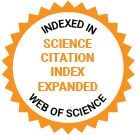Journal of Medical Internet Research
The leading peer-reviewed journal for digital medicine and health and health care in the internet age.
Editor-in-Chief:
Gunther Eysenbach, MD, MPH, FACMI, Founding Editor and Publisher; Adjunct Professor, School of Health Information Science, University of Victoria, Canada
Impact Factor 5.8 CiteScore 11.7
Recent Articles

Mesenteric malperfusion (MMP) is an uncommon but devastating complication of acute aortic dissection (AAD) that combines 2 life-threatening conditions—aortic dissection and acute mesenteric ischemia. The complex pathophysiology of MMP poses substantial diagnostic and management challenges. Currently, delayed diagnosis remains a critical contributor to poor outcomes because of the absence of reliable individualized risk assessment tools.

The success of eHealth relies on interorganizational collaboration (IOC) throughout the development, evaluation, and implementation phases of eHealth deployment. This IOC is complex, as it involves a diversity of organizations from different sectors, such as technological, academic, health care, and governmental organizations, collaborating to deploy eHealth. Between these organizations, organizational boundaries, defined as the demarcation of an organization from its environment, arise. When these boundaries are perceived as aligned and enable complementarity, IOC is facilitated. By contrast, misalignment of organizational boundaries can hinder IOC. A dialogical learning mechanism, defined as a learning process that occurs when boundaries hinder IOC, can support learning how to navigate such boundaries. However, it is difficult to determine whether and when organizational boundaries facilitate or hinder IOC, and which dialogical learning mechanisms can be used to address these challenges during eHealth deployment. Previous literature presents the barriers and facilitators of IOC during eHealth deployment only for subsets of organizations or specific phases, leaving their generic versus phase specific applicability uncharted.

Medical reports, particularly radiology findings, are often written for professional communication, making them difficult for patients to understand. This communication barrier can reduce patient engagement and lead to misinterpretation. Artificial intelligence (AI), especially large language models such as ChatGPT, offers new opportunities for simplifying medical documentation to improve patient comprehension.

Social media offers promising, low-cost, and accessible ways to promote adolescent health within their daily routines. Platforms such as Instagram engage users through interactive features—including quizzes, question stickers, and polls—that encourage participation and behavior change. However, risks such as addiction potential and exposure to harmful content highlight the need for carefully designed interventions.

Buprenorphine is a Food and Drug Administration–approved medication for opioid use disorder. However, individuals with opioid use disorder often report information needs regarding buprenorphine treatment on social media platforms such as Reddit. The field lacks a systematic approach to organizing these data and characterizing treatment information needs that may be unique and unavailable elsewhere.

The integration of large language models (LLMs) into medical diagnostics has garnered substantial attention due to their potential to enhance diagnostic accuracy, streamline clinical workflows, and address health care disparities. However, the rapid evolution of LLM research necessitates a comprehensive synthesis of their applications, challenges, and future directions.

The online environment provides adolescents with vast amounts of health-related information; however, navigating this effectively requires high levels of eHealth literacy to avoid misinformation and harmful content. Parental guidance is often considered a crucial factor in shaping adolescents’ online health behaviors; however, there is limited longitudinal research examining how parental eHealth literacy mediation influences adolescents’ development of eHealth literacy over time.

Patient-generated health data (PGHD) encompass health-related information created, recorded, and gathered by patients in their daily lives, and is distinct from data collected in clinical settings. PGHD can offer insight into patients’ everyday health behaviors and conditions, supporting health management and clinical decision-making. The Veterans Health Administration (VHA) has developed a robust infrastructure to collect PGHD, including automatically collected data from digital sensors and patient-entered data. This effort is guided by comprehensive policy and strategy documents to ensure the secure storage and effective use of PGHD. This paper describes the development and implementation of an infrastructure to support PGHD within VHA and highlights envisioned clinical and research uses of PGHD to advance healthcare for U.S. Veterans. The PGHD database was built to Fast Healthcare Interoperability Resources standards, facilitating secure data storage and exchange of PGHD. Clinical tools, such as the provider-facing dashboards, make PGHD accessible from the electronic health record. Research and evaluation efforts focus on evaluating PGHD’s impact on patient engagement, clinical outcomes, and healthcare equity. VHA’s comprehensive PGHD infrastructure represents a significant advancement in personalized healthcare and patient engagement. Integration of PGHD into clinical practice can enhance shared decision-making and self-management, while research and evaluation efforts can address how to maximize the benefits of PGHD for Veterans. VHA’s approach sets a benchmark for other U.S. healthcare systems in leveraging PGHD to achieve the broad aims of enhancing stakeholder healthcare experiences, improving population health and health equity, and reducing costs.

The proliferation of health-related content on social media platforms has changed the way people access and interpret information about cosmetic medicine. TikTok has become an important platform for sharing breast enhancement content, yet little is known about the quality, credibility, and impact of such information on user perceptions and decision-making.

Poor adherence to oral medications for type 2 diabetes can increase the risk of health complications. Digital interventions can affect people’s experiences of self-managing a chronic condition, and SMS text messages may provide an effective delivery method for an intervention. The Support Through Mobile Messaging and Digital Health Technology for Diabetes (SuMMiT-D) intervention uses evidence-based SMS text messages to support people with type 2 diabetes with regular and consistent use of diabetes medication.
Preprints Open for Peer-Review
Open Peer Review Period:
-
Open Peer Review Period:
-
Open Peer Review Period:
-
Open Peer Review Period:
-


















